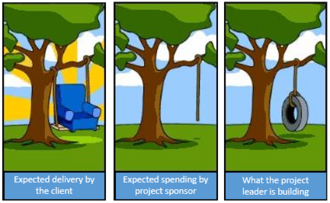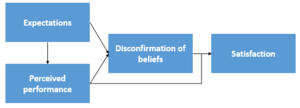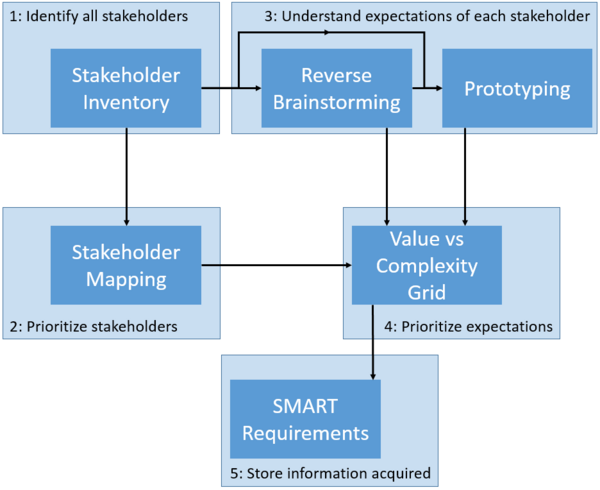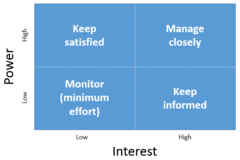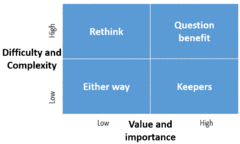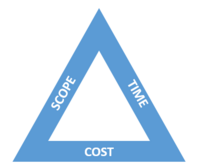Stakeholder Expectations Management
(→Reactive toolbox) |
(→Expectation confirmation theory) |
||
| Line 31: | Line 31: | ||
stakeholder groups (Taylor, 1993) | stakeholder groups (Taylor, 1993) | ||
| − | [[File:Expectation confirmation theory.png]] | + | [[File:Expectation confirmation theory.png|thumb|300px|right|figure xx]] |
=Toolbox= | =Toolbox= | ||
Revision as of 16:57, 18 September 2016
*** work in progress - sources and quotations are still not mentioned in the article.*** Other possible title: Identify Stakeholder expectations: the base of project success
Stakeholder satisfaction is a main factor in a project success. Therefore, for a project manager is vital to have under control the satisfaction of the different stakeholders.
Stakeholder satisfaction is impacted by multiple factors during a project and it can be hard to directly manage it, but it can be improved by managing and aligning the stakeholder expectations. In fact, as illustrated by the expectancy confirmation model the stakeholder satisfaction is given by the discrepancy between the perceived performance of and the prior expectations about the outcomes.
Expectations usually differ between the different parties in a project and as the number of stakeholders arises aligning becomes more and more difficult.
The scope of this article is to present a set of tool to identify and manage stakeholder expectations. The tools are applicable both in the planning and execution phases and will be divided in proactive tools, to use in the planning phase and reactive tools, to support the project execution.
For each tool a brief description should provide the reader with enough information to apply it, and links for further information.
Contents |
Project Management and Stakeholder Management
Stakeholders are defined by the ISO 21500 standard as "a person, group or organisation that has interests in, or can affect, be affected by, or perceive itself to be affected by, any aspect of the project" [ISO21500. 2012. Guidance on Project Management. International Organization for Standardization]. Therefore, any project leader should identify and categorize all the key stakeholders defining which interests they have and how important they are for the completion of the project.
TALK ABOUT PM performance domain?
Stakeholder Management is used to describe the process of identifying, assessing and building a relationship with the stakeholders. [How to do projects]
Different theories provide different criteria for project success; however recent literature is converging on defining the project success as a result of stakeholder satisfaction. Other tools like the triple constraint (http://apppm.man.dtu.dk/index.php/Project_Management_Triangle) should be used when monitoring and controlling to check whether the project is deviating from its baseline and business criteria should be taken into account. But these are not the right indicators to evaluate if a project is a success or a failure. [1]
The PMI standard PMBOK guide include the topic of stakeholder expectations in the topics of " Identify Stakeholders" and "Manage Stakeholder Engagement" that is included in "Project Stakeholder Management". However, the standards don't include particular procedures and tools to discover and manage stakeholders expectations besides the stakeholder analysis. (Project Management: A guide to the Project Management Body of Knowledge (PMBOK guide) )
The importance of expectations in stakeholder satisfaction
From the previous section we understood how important ending the project with satisfied stakeholder is for the project success. In this section two theories on the elements will be presented to understand how managing stakeholder expectation is the first step in stakeholder satisfaction.
Expectation confirmation theory
Expectation confirmation [2] theory is a cognitive theory developed in the '70 by Richard L. Oliver. It was developed in a marketing literature but from there it was applied in multiple fields since its versatility and simplicity. The first application was to explain post-purchase or post-adoption satisfaction. This effect is mediated through positive or negative dis-confirmation between expectations and performance. If a product outperforms expectations (positive dis-confirmation) post-purchase satisfaction will result. If a product falls short of expectations (negative dis-confirmation) the consumer is likely to be dissatisfied. [3] Although this gap model of satisfaction was developed primarily within marketing to explain customer satisfaction, it is likely that the relationships apply to other stakeholder groups (Taylor, 1993)
Toolbox
Proactive toolbox
Ensuring stakeholder satisfaction is a process that starts before a project begins. The planning phase is the most crucial in understanding what value is expected by the various stakeholders and how to actually deliver it. In this phase, stakeholders expectations have to be aligned and, when this is not possible prioritized. However, stakeholders most of the time are not able to clearly explain their expectation. That is why in the toolbox two tools are dedicated to extract hidden desires and avoid communication misunderstanding. Once the expectations are clearly understood, the project leader should store the agreement in a written form to inform the project team on the goals and have a written proof in case that stakeholders change their mind. Indeed, once the project starts, modifications to satisfy stakeholders who were not included in the planning phases can cause big delays and cost increase.
Stakeholder inventory
The first step of managing the stakeholders expectation is to have the complete picture of who is a stakeholder in the project. The best method to create an exhaustive list is to hold a brainstorming workshop between the project team. The objective in this phase is to think creative to include every possible stakeholder. For normal projects, a brainstorm of 10-15 minutes should be sufficient.
Stakeholder mapping
From the stakeholder inventory is important to prioritize the stakeholders in base at their relationship with the project. For the purpose of this article, the theory background and detailed explanation on the different version of the tool will not be presented. The page Stakeholder Analysis explains in depth the concept and it's application.
The suggested version of the stakeholder mapping is the Power/Interest diagram. It is created by positioning the stakeholders in the different areas according to the estimated power, how much a stakeholder can affect the project, and interest, how much a stakeholder is involved in the project.
The x axis represents the interest, so the interest increases going from the left to the right. The y axis represents the power, so the power increases going from the bottom to the top.
Reverse brainstorming
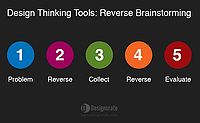
Trying to understand the stakeholder expectation in a project, a main issue can be found in the lack of a clear vision from the stakeholder of its desires. If asked with direct questions like "What do you expect this project to achieve?" or "How will this project help you?" stakeholders can have some difficulties in answering.
Reverse brainstorming is a 5 step progress that solves the problems of direct questioning by exploring multiple factors in reverse. This encourages more creative thoughts creating robust solutions.
The project leader should reverse the question he would need to understand the expectations. Examples could be "How can the project dissatisfy you?" and "How could we fail this project?"; by asking this kind of questions participation is encouraged through outside-the-box thinking.
From this first first phase, the negative ideas generated are reversed again to understand what are the positive expectation of the stakeholder. [4]
Prototyping
After some meeting and information exchange the project leader should have a preliminary idea of the expectations of the stakeholder. In case this expectations concern data and measurable results it is easy to communicate and agree with the stakeholder. However, many times the expectations regard subjective evaluation and even if the two parties agree it is not obvious that they are picturing the same result.
Therefore, before closing the confrontation with the stakeholder about their expectations is important to make sure that there during the process misunderstanding caused a distance between the actual expectation and what the project leader understood A prototype is an early sample, model, or release of a product built to test a concept or process or to act as a thing to be replicated or learned from. To make
Value vs complexity grid
SMART requirements agreement
After multiple iteration at this phase stakeholder expectations should be clear. However, it is necessary to formally store the information collected as a project requirement both to inform the project team avoiding internal misalignment and have a agreement proof in case a stakeholder changes its mind.
A requirement is nothing more than an expected outcome of the project. However the way the requirement is formulated should not leave space to interpretations. In the absence of facts and details, the stakeholder will interpret and make up assumptions. Moreover, everything should be stated in the requirements, if it is not stated, it is not committed to be completed.
To ensure a flawless requirements definition each requirement should be expressed through a SMART framework find another source
| Specific | Measurable | Attainable | Realistic | Time-bound | |
| Explanation | a good requirement is specific and not generic. It should not be open to mis-interpretation when read by others. | this answers whether you will be able to verify the completion of the project. You should avoid signing up for any requirement that cannot be verified as complete. | the requirement is physically able to be achieved given existing circumstances | answers whether the requirement is realistic to deliver when considering other constraints of the project and requirements | specify by when or how fast a requirement needs to be completed or executed |
Reactive toolbox
Even after a meticulous planning process to understand and accommodate stakeholder expectations new and unexpected expectations could emerge. This new expectations could emerge from stakeholders that were not considered or by changes in the environment (example: new regulation)
Once the project leader discover this mismatch, he/she has to act to understand what in the interest behind this new expectations. Negotiation technique can support this process limiting the divergence from the original plan.
If there is no way to avoid changing plans, a delicate phase opens where the project leader has to understand how changing some parameters will influence the rest of the project.
Issue log
When analyzing stakeholder expectation and issue represents the distance between the stakeholder expectation and the reality of the project. An issue log, in general project management term, is a documentation element of software project management. An issue log contains a list of ongoing and closed issues of the project. While issue logs can be viewed as a way to track errors in the project, the role it plays often extends further. Issue logs can be used to order and organize the current issues by type and severity in order to prioritize issues associated with the current milestone or iteration.[5]
Integrative bargaining
Integrative bargaining is a negotiation strategy in which parties collaborate to find a "win-win" solution to their dispute. This strategy focuses on developing mutually beneficial agreements based on the interests of the disputants. [6]
A short video to visualyse the benefits of Integrative bargaining as explained in the article.
Project Management Triangle
The Project Management Triangle (called also Triple Constraint or the Iron Triangle) is a model of the constraints of project management. Following the definition of a new expectation this tool can support the understanding of how the rest of the project will be impacted to satisfy this new expectation. In fact one side of the triangle cannot be changed without affecting the others.This triangle reflects the fact that the three properties of a project are interrelated, and it is not possible to optimize all three – one will always suffer. [7]
Other tools
RACI Matrix / will be probably removed
The Responsibility Assignment Matrix (RACI Matrix) focuses on clarifying what stakeholders roles and responsibilities are in a context of a specific task or process step. It classifies stakeholders according to one of the following roles for specific project activities:
Responsible: The stakeholder performs the project work activities.
Accountable: The stakeholder is accountable to the sponsor or to the customer for the result of the work activities.
Consulted: The stakeholder is asked for opinions on objectives, assumptions, constraints, or methods of planning and developing products or process due to expertise or position in the organization.
Informed: The stakeholder is notified of the outcome of project decisions.
Using this matrix, the project leader can control which stakeholder should be informed or consulted in regards to a certain task
Field of application toolbox
Case Example
Template
Limitation
-Personal skills of PM are extremely important
Number of stakeholders
